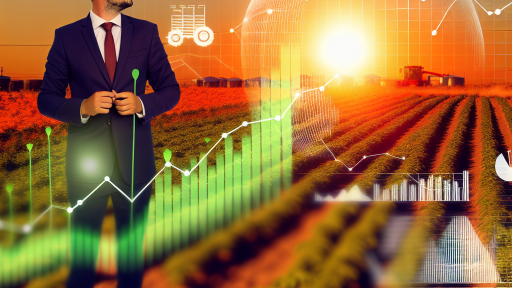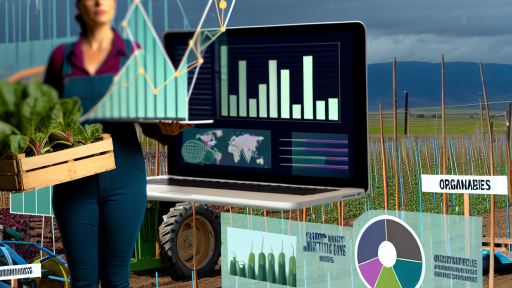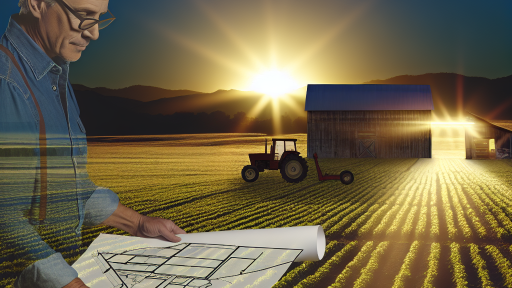Impact of Climate Change on Crop Yields
Changing Weather Patterns
Climate change is altering traditional weather patterns globally.
Farmers now face unpredictable rainfall and changing temperatures.
These changes significantly affect crop growth and health.
Moreover, extreme weather events such as droughts and floods pose additional challenges.
This variability directly impacts crop yields and farmer livelihoods.
Shifting Growing Seasons
As temperatures rise, growing seasons are shifting.
Crops may mature earlier or later than before.
This change can disrupt traditional farming practices.
Farmers may need to adapt by planting different crops or adjusting planting schedules.
Such adaptations may require new skills and techniques.
Soil Health and Fertility
Climate change negatively impacts soil health.
Increased rainfall can lead to soil erosion and nutrient loss.
Consequently, farmers must invest more in soil management practices.
Additionally, changes in temperature may alter soil microbial activity.
These shifts can affect nutrient availability for crops.
Transform Your Agribusiness
Unlock your farm's potential with expert advice tailored to your needs. Get actionable steps that drive real results.
Get StartedPest and Disease Pressure
Warmer temperatures can lead to increased pest and disease pressures.
Crops that are vulnerable may face higher risks of infestation.
Farmers must adopt integrated pest management strategies to combat these threats.
Furthermore, resilience against these challenges is crucial for maintaining yields.
Adaptation Strategies
Farmers are exploring various adaptation strategies to mitigate climate impacts.
These strategies include diversifying crops to spread risk.
Additionally, they are adopting advanced irrigation techniques to optimize water use.
Using climate-resistant crop varieties can also enhance resilience.
Finally, education and resources are vital for successful adaptation.
Technological Advancements in Precision Agriculture
Overview of Precision Agriculture
Precision agriculture enhances farm management through technology.
This approach enables farmers to improve crop yields efficiently.
Technological innovations play a crucial role in resource management.
Farmers can control inputs like water and fertilizer more accurately.
Use of Data Analytics
Data analytics allows farmers to make informed decisions.
They collect data from various sources, including sensors and satellites.
Farmers analyze data to predict yield outcomes accurately.
This information helps optimize planting and harvesting schedules.
Integration of Drones
Drones are revolutionizing agricultural monitoring practices.
Farmers use drones for aerial imagery and crop assessment.
This technology enables quick identification of problem areas.
Consequently, farmers can implement targeted solutions rapidly.
Advancements in Soil Sensors
Soil sensors provide real-time data on soil health.
This technology measures moisture, pH, and nutrient levels.
Farmers can adjust their practices based on sensor feedback.
Showcase Your Farming Business
Publish your professional farming services profile on our blog for a one-time fee of $200 and reach a dedicated audience of farmers and agribusiness owners.
Publish Your ProfileAs a result, they can enhance soil fertility and crop health.
Benefits of Automation
Automation simplifies farming operations significantly.
Robotic systems assist with planting, weeding, and harvesting.
Farmers experience reduced labor costs and improved efficiency.
Such advancements lead to increased productivity on farms.
The Role of GIS Technology
Geographic Information Systems (GIS) improve land management.
GIS technology helps in mapping field variability.
Farmers can visualize data and make strategic decisions easily.
This technology enhances precision in land use planning.
Future Trends in Precision Agriculture
The future of precision agriculture looks promising with AI integration.
Artificial Intelligence will drive more automated farming systems.
This will further refine accuracy and resource management.
Technological advancements will shape sustainable farming practices.
Market Demand for Organic and Non-GMO Crops
Growing Consumer Preferences
Today’s consumers increasingly prefer organic and non-GMO products.
This shift reflects a deeper awareness of health and environmental issues.
Many are willing to pay a premium for these products.
As a result, retailers are expanding their organic offerings.
Impact of Certification
Certification plays a vital role in consumer trust.
Labels like USDA Organic create a sense of assurance for buyers.
Many farmers seek these certifications to meet market demand.
Consequently, they invest in organic farming practices.
Market Access and Distribution Channels
Access to markets is crucial for organic producers.
Farmers establish connections with specialty grocery stores.
Online platforms also help small producers reach customers.
This diversification enhances their overall market presence.
Environmental and Health Benefits
Organic farming methods improve soil health and biodiversity.
These practices also reduce chemical runoff into water bodies.
Many consumers associate non-GMO crops with healthier diets.
Thus, the perceived benefits drive market demand.
Trends in Agriculture Technology
Advancements in technology support organic farming efforts.
Farmers utilize precision agriculture for enhanced efficiency.
These tools optimize resource use and reduce waste.
Technology allows for monitoring crop health in real-time.
Challenges in Production
Despite the growing demand, challenges persist in organic farming.
Pest control without synthetic chemicals can be difficult.
Additionally, organic crops often yield less than conventional ones.
Farmers must balance these challenges with consumer expectations.
Gain More Insights: Key Factors Shaping Agricultural Markets Today
Influence of Global Trade Policies on Agricultural Markets
Overview of Global Trade Policies
Global trade policies significantly shape agricultural markets worldwide.
These policies can either promote or restrict agricultural exports and imports.
Showcase Your Farming Business
Publish your professional farming services profile on our blog for a one-time fee of $200 and reach a dedicated audience of farmers and agribusiness owners.
Publish Your ProfileTrade agreements often determine the flow of agricultural goods between countries.
International negotiations influence tariffs, quotas, and subsidies.
Impact of Tariffs on Crop Production
Tariffs can increase the cost of imported agricultural products.
Higher costs often lead to reduced competitiveness for foreign goods.
Consequently, domestic producers may benefit from less foreign competition.
However, retaliatory tariffs can provoke trade wars that hurt everyone.
Farmers may face challenges such as fluctuating prices and market uncertainty.
Effect of Subsidies on Market Dynamics
Subsidies help stabilize income for farmers in many countries.
They enable producers to remain competitive in the global market.
However, subsidies can create an uneven playing field among nations.
Countries with extensive subsidies may dominate crop production globally.
Regional Trade Agreements and Their Role
Regional trade agreements facilitate easier access to markets.
They often reduce trade barriers between participating countries.
For example, the USMCA encourages agricultural trade between the US, Canada, and Mexico.
This agreement boosts exports and strengthens agricultural ties in the region.
Case Studies of Recent Trade Policies
The U.S.-China trade tensions highlight the impact of policy changes.
Many American farmers faced challenges due to increased tariffs on exports.
Similarly, the EU’s Common Agricultural Policy affects member states substantially.
European farmers benefit from subsidies, but competition from non-EU countries increases.
Future Trends in Agricultural Trade Policies
Future trade policies may increasingly focus on sustainability.
Countries may prioritize environmentally friendly practices in agriculture.
Furthermore, digital trade policies will likely evolve to facilitate transactions.
These shifts will influence how crops are produced and marketed worldwide.
Explore Further: Analyzing Market Demand for Modern Farmers
Rising Input Costs
Fertilizers
The agricultural sector faces increasing fertilizer costs.
These hikes significantly affect farmers’ budgets.
Several factors drive up prices, including global demand.
Supply chain disruptions also contribute to this issue.
Farmers must adjust their strategies to manage these costs.
Some may seek alternative fertilizer sources.
Others might consider using less fertilizer to save money.
Seeds
Seed prices are also on the rise, creating financial strain.
Genetic advancements often lead to higher seed costs.
Moreover, climate change impacts the varieties needed.
Farmers must invest in high-quality seeds for better yields.
Consequently, many are exploring seed-sharing networks.
Collaborating can ease individual financial burdens.
Water
Water scarcity is becoming a critical concern for crop production.
With rising temperatures, irrigation needs are increasing.
This trend drives up the cost of water access and management.
Showcase Your Farming Business
Publish your professional farming services profile on our blog for a one-time fee of $200 and reach a dedicated audience of farmers and agribusiness owners.
Publish Your ProfileFarmers are exploring more efficient irrigation techniques.
Tech innovations can significantly reduce water usage.
Additionally, rainwater harvesting presents sustainable options.
Investing in water-saving technologies is now crucial.
Delve into the Subject: Navigating Commodity Price Fluctuations in Farming

Consumer Trends Towards Locally Sourced Produce
Growing Awareness of Food Origins
Consumers increasingly desire to know where their food comes from.
This interest drives them to seek locally sourced options.
They believe local produce supports their community and economy.
Moreover, many view local foods as fresher and healthier choices.
Support for Local Farmers
Many consumers actively support local farmers and markets.
This trend contributes to a more sustainable food system.
Locally sourced produce benefits farmers directly by increasing sales.
Additionally, consumers appreciate the stories behind local products.
Impact of Social Media
Social media plays a significant role in promoting local produce.
Platforms like Instagram showcase beautiful images of fresh food.
Influencers often advocate for supporting local farmers’ markets.
This visibility influences consumer purchasing decisions significantly.
Health Conscious Choices
Health-conscious consumers often prefer local produce.
They associate it with fewer pesticides and chemicals.
Furthermore, locally sourced items typically have higher nutritional value.
Consequently, many choose local options for their better health benefits.
Environmental Considerations
Environmentally aware consumers are also drawn to local produce.
They recognize that local foods reduce transportation emissions.
This trend aligns with sustainable living practices they endorse.
Additionally, it encourages biodiversity in local agricultural practices.
Challenges and Considerations
Despite these positive trends, challenges exist for local agriculture.
Seasonality affects the availability of certain produce items.
Furthermore, local farms may struggle with competition from larger retailers.
Consumers must balance quality, convenience, and pricing when choosing.
Implications for Future Purchasing
Consumer trends increasingly favor locally sourced produce.
These trends support farmers and promote sustainable practices.
As awareness continues to grow, local markets may thrive further.
Gain More Insights: Consumer Preferences and Their Impact on Farms
The Role of Sustainable Farming Practices in Market Viability
Importance of Sustainability
Sustainability plays a crucial role in today’s agricultural markets.
Farmers increasingly adopt practices to ensure environmental health.
Such methods lower the carbon footprint of crop production.
Moreover, they contribute to preserving natural resources.
Consumer Preferences
Today’s consumers favor sustainable products over traditional ones.
They actively seek food options with minimal environmental impact.
This shift influences market demand significantly.
Showcase Your Farming Business
Publish your professional farming services profile on our blog for a one-time fee of $200 and reach a dedicated audience of farmers and agribusiness owners.
Publish Your ProfileBrands embracing sustainability often enjoy increased customer loyalty.
Regulatory Trends
Regulations surrounding agricultural practices are evolving rapidly.
Governments are implementing stricter guidelines for farming.
Compliance with these regulations enhances market viability.
Failing to adapt risks losing market access.
Economic Benefits
Sustainable practices often lead to lower long-term costs.
Efficient resource use maximizes profitability.
Additionally, organic certification can open new sales channels.
Investing in sustainability breeds innovation in agricultural methods.
Collaboration and Community Engagement
Farmers benefit from sharing knowledge and resources.
Cooperatives can enhance sustainability efforts collectively.
Community-supported agriculture encourages local food systems.
Such initiatives strengthen the connection between producers and consumers.
Effects of Labor Shortages on Crop Production and Prices
Current Labor Challenges in Agriculture
The agricultural sector faces significant labor shortages.
Farmers struggle to find enough workers for planting and harvesting.
This challenge has intensified in recent years due to immigration policies.
As a result, many farms must rely on a smaller workforce.
This reality directly affects productivity levels.
Impact on Crop Production
Reduced labor availability leads to decreased crop output.
Farmers may not be able to harvest crops on time.
This situation can cause significant losses in yield.
Some crops simply spoil in the fields due to neglect.
Lower production rates inevitably lead to scarcity in supply.
Effect on Prices
As crop production declines, prices begin to rise.
Higher prices affect both consumers and agricultural businesses.
Consumers face increased costs for fresh produce and grains.
Furthermore, rising input costs strain farmers’ profit margins.
This scenario might force some farmers out of business.
Adaptation Strategies by Farmers
In response to labor shortages, many farmers adapt their methods.
Some invest in technology and automation to reduce dependency on labor.
Precision agriculture tools help maximize efficiency and yields.
Others focus on crop types that require less intensive labor.
These strategies may mitigate some negative effects of labor shortages.
The Future of Agricultural Labor
Looking ahead, the labor market in agriculture remains uncertain.
New policies may alter the availability of seasonal workers.
Long-term solutions are necessary to secure a stable workforce.
Collaboration with educational institutions can help bridge skills gaps.
Moreover, improving labor conditions may attract more workers.
Additional Resources
Climate Change Impacts on Agriculture and Food Supply | US EPA
Showcase Your Farming Business
Publish your professional farming services profile on our blog for a one-time fee of $200 and reach a dedicated audience of farmers and agribusiness owners.
Publish Your Profile



